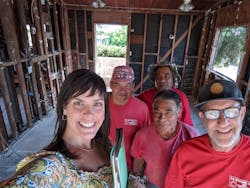A Catalyst for Change
Alena Brooks Blasio was driving her remodeling company’s truck three weeks after buying the firm from her father. It had been three weeks filled with final studying for her contractor state license board exam. Three weeks of anticipation. And three weeks that would come to a harsh stop when a car running a red light hit Blasio’s truck.
The accident totaled her vehicle, sent her into shoulder surgery, and resulted in many months of recovery. The typically fast-paced Blasio quickly returned to work, hitting the jobsite as she did each day. But then the biggest challenge from her accident would reveal itself.
“I was on a jobsite with my electrician and we were laying out sconces for a vanity,” recalls Blasio. “I was doing the math in my head and every single one of the calculations was incorrect. He’s like, ‘I think something’s wrong.’”
Several MRIs and scans revealed that the accident caused brain damage, specifically post-concussion syndrome. Blasio, purchased BA Worthing from her father in June 2020, but had been transitioning into the role for several years. The busy company served all of San Diego’s North County region. Her work led up to the exciting purchase and new path ahead, but the accident resulted in doctor’s orders to stop working.
RELATED: 2022 Forty Under 40: Alena Brooks Blasio
Doctor’s Orders
It was a shockingly abrupt change for Blasio who had always worked in the industry. Her father first brought her on the jobsite at 5 years old, for a role which included payment of a single penny for each nail picked up. Those years expanded into opening a design company with her father at the age of 18.
While production was her dad’s focus, Blasio’s passion for design and architecture led her to carve her own career in commercial design, partnering with a local California firm and then moving to upstate New York, jumping from working with a renowned metal sculptor to designing for one of the region’s largest supermarket chains, Wegmans.
Doctor’s orders to pause work placed Blasio in a lull for a year.
“The only way to eat an elephant is one bite at a time,” says Blasio. “I did everything the doctors told me to. They said you need to stop setting an alarm, you have to sleep until your body naturally wakes up. You need to change your schedule for work, completely standardize it so all your appointments are only at certain times of the day, and then also do cognitive therapy.”
She took the same approach to transitioning into ownership prior to the accident, tackling one challenge at a time. But the largest challenge for Blasio even prior to the accident had been filling the shoes of her father who had built a strong network of trade partners and work.
RELATED: How We Nurture Trade Partner Relationships
Designing a New Path
Being the main general contractor for the majority of their subcontractors meant their livelihood depended on the success of Blasio.
“My electrician, for instance, said a lot of us were kind of nervous about whether or not you could fill your dad’s flip flops and be able to run things the way that he did,” recalls Blasio. “And he said, now that it’s been four years, we all realize that we’re better off with you than we were with your dad.”
She wasn’t just a new owner either, she’s also a woman. In the male-dominated industry, Blasio learned to take the pop quizzes men on the jobsite would throw at her to determine whether or not she knew what she was talking about. “It was almost a little bit of hazing, to be honest,” she says. “I take it as a challenge, and for me, a good challenge is always a good thing.”
A shift in ownership came with a business redesign. With a background heavy in design and a changed life perspective, Blasio remodeled what the traditional construction business owner’s priorities were and adjusted the business’s model.
She would not go into the office at 5 am like her father did anymore. She would push her trade partners to do work they never had. She would take the business model to a full design-build platform.
“In the recovery process from this car accident I realized that if I didn’t change something wasn’t going to be sustainable for the long term,” recalls Blasio.
In turn, jobs became more profitable, client selection more intentional, and Blasio became a better leader, mother, and business owner.
“It was a catalyst for me to completely change the way I was doing everything,” she says.


